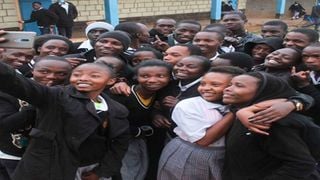
Students at Elburgon DEB Secondary School in Nakuru County take a selfie during prayer day on December 18, 2021.
| John Njoroge | Nation Media GroupWeekend
Premium
We need to talk honestly about state of education
What you need to know:
- Like the proverbial ostrich, those in charge of education persist in denying that the education sector is in a bad shape.
- We need to discuss the practicalities of modifying the national curriculum to fit into the needs of different Kenyan children.
There is no doubt that our education system is in a crisis. Secondary schools have been burning in the recent past. Learners have been reported choosing to leave for home instead of studying.
Whispers about schools being overcrowded have become noises. It is common knowledge that many of the secondary schools are understaffed.
The 100 percent transition is something to be proud of — after all, every child deserves to be educated up to the highest level — but it has strained schools.
Primary schools are overfilled, lack classrooms, desks, staff rooms, playgrounds etc. In simple words, our public schools are in trouble. The CBC, the denials notwithstanding, has added extra costs to the parents’ budgets in this deteriorating economy.
The universities are in bad shape. The common story out there is that they are broke. The least known story is that they don’t have enough teaching staff — many of the old universities have had highly qualified staff retire without being replaced.
More than half the public staff rely on part time teachers, who they hardly pay. Everyone who has something to say about education is crowing about technical colleges.
State of education sector
Yet, they hardly have the equipment and teachers to properly train the young school leavers they are admitting. Some of the equipment in some of the old technical schools are museum material.
However, like the proverbial ostrich, those in charge of education persist in denying that the education sector is in a bad shape. They insist that things are under control.
But life can’t continue as usual in our schools when the classrooms, laboratories, bathrooms, toilets, dormitories, playgrounds and school compounds are inadequate. There is practically no breathing space in some classes — and here we are talking from the kindergarten all the way to the university.
So, why can’t the government simply organise a national conference to discuss the state of the education sector? Let’ s talk about the kinds of curricula we need in this country. I say curricula because, although the government always talks about one curriculum, millions of Kenyan children learn under different curricula, most of them study a modified versions of the government one.
Kenyans need to talk about the interconnectedness of the national curriculum and the foreign ones (such as IB, IGCSE or Montessori) and those from the other East African community countries, and the even those from the rest of the world. We need to discuss the practicalities of modifying the national curriculum to fit into the needs of different Kenyan children, across cultural, regional, class, or ability divides.
The writer teaches literature and performing arts at the university of Nairobi. [email protected]





